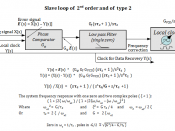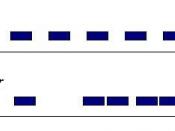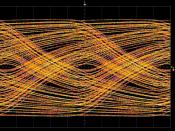Jitter is variability in latency, or delay. Jitter is also the tendency towards lack of synchronization caused by mechanical or electrical changes. It is the phase shift of digital pulses over a transmission medium (Newton's Telecom Dictionary, 18th Ed.). In lemans terms, jitter is the short term "shaky" pulses or slight movement in time or phase that can introduce errors and loss of synchronization on an amplitude modulated signal.
If there is jitter on a transmitted signal it could lead to the degradation in system error performance, slips in the timing of a circuit which would lead to errors on the circuit and the distortion of the analog signal after the decoding or the digital signal has taken place. There are several different causes for jitter. One reason for jitter could come from the conversion from analog to a digital signal or vice versa. If the timing on a circuit and on the equipment that does the conversion of A to D and D to A is not properly matched and in sync the circuit could take errors and cause jitter.
Clocking and where clocking comes from could cause jitter. For example, if the 5ESS provides the 'master' clocking on a T-1 line for a customer, the customer's PBX must 'slave' timing or accept the timing from the 5ESS. The PBX must do all of the clocking needed from the master source. If the PBX was set up to be the master and the 5ESS was also the master there would be clocking errors causing jitter on the circuit. Another cause of jitter can come from bad or faulty cabling. If copper cabling is not properly run, secured and tested the copper can pick up errors by way of noise, power fluctuations, bad weather and interference thus causing jitter. Jitter can also come from asynchronous multiplexers (e.g. the M13 MUX) because of the bit-stuffing and the extraction of bits.
Wander is the long-term phase variations of the significant instants of a digital signal from their ideal position in time. Wander is a matter of synchronization errors in digital networks (Newton's Telecom Dictionary, 18th Ed.). In lemans terms, wander is the same as jitter, but is a much slower form of jitter. Wander occurs at a lower frequency then jitter.
There are several factors that can cause wander on a circuit. One reason for wander could be if the span that was run to the customer was too far away from the central office without a repeater placed in the circuit, wander can occur. Some more reasons for wander include propagation delays and temperature changes.
In conclusion, both wander and jitter are two types of errors that can severely impair a transmission line. Wander and or jitter on a transmission line could look/sound like pops or clicks on a voice circuit; fax machines could lose scan lines; modems can disconnect and video conferencing can be impaired by frame jumps. Although these errors are a nuisance, they can still be trouble shot and repaired. A T-Berd can identify the errors and help to figure out a solution for the problem. Copper spans can be replaced; repeater can be put on a line; clocks can be synchronized and equipment can be replaced.


